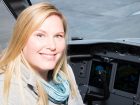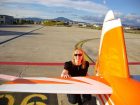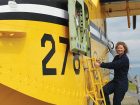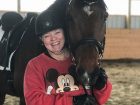
News
My aviation journey
The Northern Lights Aero Foundation in May 2018 introduced eight recipients of its 10th annual Elsie MacGill Northern Lights Awards. Each year, the foundation honours outstanding Canadian women who have made significant contributions in their field of aviation and aerospace.
August 30, 2018 By Compiled by Anna Rusinowski
We asked the honourees to share favourite stories from their journey so far. (For full bios and stories check out Wingsmagazine.com/Elsie)
Pioneer Award
Major Micky Colton, Royal Canadian Air Force, retired
I was in Moose Jaw on the jet phase of my military wings training. The progression is to train on clear hood missions (read as Visual Flight conditions) and move on to instrument, navigation and formation flights before graduation. I had only completed part of the clear hood flying phase and had started IFR training, I could climb/descend and make turns on instruments. One afternoon, my instructor gave me my marching orders and sent me out solo to practice simple aerobatics and then rejoin the circuit for a few touch and goes before terminating. It is important to note that the Tutor aircraft was also called the 2,000-pound whistle as it did not carry a whole lot of fuel. Also of note, there were, and probably still are, two parallel runways in the Jaw. The outer was for touch and goes and the inner was for full-stop landings.
I was out in the practice area, merrily practicing loops and rolls and a call came in from the tower recalling all of the solos back to land. I came back for a rejoin on long final for the outer runway and got cut off by another aircraft coming in on a shorter diagonal to base leg. I asked to fly through between the runways and join the pattern for the inner. I was given authority to do so and, as I flew between the runways, I could see that the departure end was pretty fuzzy-looking weather-wise. But, like the newbie I was, I carried on. I was cleared to turn right to join the inner pattern just as I flew into the soup. By the time I realized there was nothing to be seen out of my window and transitioned to instruments, I was in a 60 degree and increasing right turn and heading downwards at a good clip from 1,000 feet above ground.
I hit the stick, righted the aircraft and slammed on the power and started to climb. My parachute harness was vibrating from the speed. My heart was racing. As I climbed through 1,000 feet I called the tower and told them I was lost – because I was. None of this mincing around with being temporarily unsure of my position, I was downright lost. Tower told me to climb until I hit VFR conditions. I broke out at 19,000 feet. Moose Jaw had gone zero visibility, zero cloud height from a huge grass fire just west of the base. Tower asked if I knew how to fly a lost pattern. Two-minute triangles! I could do that. They vectored another instructor and a classmate up to me. Prettiest thing I have ever seen was that Tutor punching up through the clouds beside me.
The other instructor had me become formation lead (my first formation flight!) and he vectored me to Regina as we weren’t getting into Moose Jaw anytime soon. He told me later that I didn’t vary more than a degree of the headings he gave me. Nothing like a little terror to make your hands steady. He set me up on final for landing runway at Regina (40 nm or so from Moose Jaw) and flew beside me until I landed. He also told me to wait for him just off the runway. I waited quite a while as he flew into the smoke front, which had raced us all the way to Regina and had to recover IFR. I didn’t tell him until we were finally parked that my low fuel light had been on for quite a while on final approach. I called my instructor, he gave me hell for leaving the circuit! But then he came to get me and flew me back to the Jaw after the smoke went through. I learned then and there to trust my instruments and my instincts – a scary but valuable lesson.
Flight Operations Award
Julie Beverstein, assistant chief pilot, recruitment and retention, Porter Airlines
Anyone who knows me knows I have a no filter and will often speak my mind without thinking it through. This has definitely created some embarrassing situations once or twice. This story is from almost 10 years ago when I was a pilot at Air Georgian. We were sent off to Bedford Massachusetts to pick up some passengers and fly them to Buffalo, wait, and then fly them back to Toronto.
It was a hot day, no air conditioning, and when a small bus of passengers arrived we starting working quickly to load the plane and get going. For some reason I had it in my mind we were picking up teachers from a conference. After the small bus backed up to the cargo door, we began loading. We were loading boxes and odd shaped pieces of luggage. I picked up one that was clearly a set of drum kit cymbals. I looked at the guy in charge of the group and asked, “Are these cymbals?” “Yes,” he replied. I then asked, “Are you in a band or something?” He looked at me confused and said “Have you heard of Pink Floyd?”
I thought he was full of it and said, “Yeah, whatever – keep Loading!” Once the loading was done and I went on the plane to brief the passengers, I realized they were old and British and looked like they may have lived through a thing or two! I thought oh, crap! Anyway, it was hot and we had a job to do.
Soon after, we could hear the women backup singers singing and the captain said, “How annoying.” I agreed and explained the back was loaded with instruments, that one of the passengers mentioned Pink Floyd, but as if they would be flying Air Georgian. Well, wouldn’t you know it! It was Roger Waters and his band. They were flying to Buffalo to perform.
We had the manifest for customs and a quick search on our phone verified I had once again put my foot in my mouth. Although I do my best to be professional at all times, this story is a reminder that you never know who is on your plane as a passenger and a momentary pause to think before speaking can save a lot of embarrassment.
Government Award
Emily Crombez, captain, WestJet Airlines
It was a typical Spring day on red alert in Thunder Bay, Ont. – sitting around, waiting for the fire bell to sound. A friend stopped by for a tour of the mighty CL-415 waterbomber. Everyone is amazed by the three by five inch probes that scoop 1,350 imperial gallons of water in only 12 seconds. Of course, mid-tour is when the bell sounds and we have five minutes to be airborne and enroute to a fire near Stanley, just west of Thunder Bay. My friend happens to live in that direction, so her tour turned into a live action-packed afternoon of watching us bomb a grass and brush fire that was threatening houses in the area. We were scooping water out of Lake Superior – this was the closest water source that wasn’t still frozen in early Spring.
Our standard calls after airborne with a load of water are “Tanker 272 up with a load.” As we were scooping and transitioning through the Thunder Bay control zone, we were repeatedly making these calls to tower. After a few radio calls, I mistakenly changed the phraseology to “Tanker 7-up…with a load” and immediately looked left at my captain who was already laughing.
Red in the face, knowing I had several friends flying for local operators who heard me, on top of Tower and the fellow tanker working the fire with us, I knew I’d hear about it. I thought the text messages and voicemails post landing poking fun at my 7-up were the end of it, until I showed up to the tanker the next morning, and there was a note “You ordered this from the Tower folks,” along with four cans of seven-up on my seat! It turned out to be an exciting day for my friend, and a few good laughs to keep the tanker base and tower entertained.
Business Award
Julie Mailhot, chief operating officer, Air Georgian
My career in aviation began in 1987, working in reservations and later at the Dorval airport. In the early 90s, while working in the Weight and Balance department, I had the opportunity to chat with flight dispatchers quite regularly and became interested in dispatching. In 1994, I heard of an opening in the Flight Dispatch Department in Toronto and immediately inquired about qualifications for the position. I was quickly dissuaded, being told there were no women in this position, and that I would need to become a pilot.
Determined, I took a private pilot course and immersed myself with books and other materials to study meteorology on my own time. In 1995, my dedication paid off, and I was hired as the first woman assistant flight dispatcher at Air Canada. While this was a great accomplishment, still others did not recognize my value – often having me file papers and do other clerical work rather than assisting in dispatching.
In 1996, I was able to obtain my licence after successfully passing the Transport Canada operations and meteorology exams. For about six months after becoming a licensed flight dispatcher, every time a pilot would call for a briefing or to ask a question they would ask to speak to the real flight dispatcher, or would request a supervisor, as they did not trust what I would tell them.
Later, I went on to become the first woman chief duty dispatcher, then chief of operations, and ended up being the director of the entire department which included Flight Dispatch, Aeronautical Support, and Weight and Balance. Today, I am proud to hold the position of chief operating officer at Air Georgian, overseeing all aspects of our operations, and helping to prepare Air Georgian for future growth opportunities.
There has been a lot of awareness recently about the lack of women in aviation, whether it be in pilot or flight dispatcher positions, in maintenance, or management. Looking back at my journey, and the struggles I faced progressing in aviation, this is not surprising. However, the industry has progressed, and due to the dedication and commitment of fellow female leaders in aviation, we are creating greater awareness and opportunities for women in our industry. The negativity and discrimination I faced was fuel for the fire, motivating me to push for change in a field I am passionate about. I am so proud today to be able to speak about my journey, and hopefully inspire other young women to pursue their passions regardless of any negativity they face. Girls can fly!
Education Award
Dr. Alexandra Kindrat, educater and research scientist
One never knows where life’s journey will lead, or which past experiences will open doors to incredible future opportunities. At 17 years of age, when I earned my private pilot’s license, I never expected to be conducting research at NASA’s Johnson Space Centre in Houston, nor have the opportunity to collaborate with astronauts and space physiologists in conducting research on the International Space Station, or have my space research presented at international conferences.
After completing my Master’s degree in Neurology and Neurosurgery at McGill University’s Faculty of Medicine and further obtaining my teaching license, I was awarded a scholarship to study at the International Space University in Strasbourg, France. As a result of having a background in health and medical sciences, as well as aviation, I was asked to join a team of researchers that would conduct research on the International Space Station. This was certainly an extraordinary experience for me.
Under the leadership of space physiologist Dr. Gilles Clement and Canadian astronaut Dr. Robert Thirsk, our research team conceived and designed experiments aimed to investigate depth perception in astronauts during and after spaceflight by studying their sensitivity to reversible perspective figures, wherein two-dimensional images could elicit two possible depth representations. In simpler terms, our study aimed to investigate if the reversal between perceptions of a given image was faster or slower in a micro-gravity environment compared to on Earth.
After its conception, our experiment was entered in a contest entitled The Aerobatics Zero-Gravity Challenge, which would allow our team to fly our experiment on a parabolic flight, prior to being conducted on the International Space Station. Our research experiment won and our team travelled to Barcelona, Spain, to conduct our experiment on a parabolic flight. The following year, after finalizing our research experiment, I had the opportunity to present our research proposal to astronauts at NASA’s Johnson Space Center.
Six astronauts agreed to participate in our research experiment, and they were tested over four sessions during their six-month mission aboard the International Space Station. They were then tested again after returning to Earth. The results obtained revealed that depth perception is altered in space compared to on Earth. On Earth, participants reported seeing one percept of the reversible figure 70 per cent of the time, whereas during spaceflight each percept was visible for equal amounts of time.
Collaborating on this research was certainly an incredible and wonderful experience for me. Our research was presented at conferences in Belgium, Germany, South Africa, The Netherlands and Italy. As an educator, I refer to this experience often when speaking with my students. I encourage them to continue setting goals for themselves. One never knows where past experiences may lead. If one continues to work hard, opportunities will always present themselves.
Engineering Award
Niloofar Moradi, Turbine Design, Pratt & Whitney Canada
Moradi earned her undergraduate degree in mechanical engineering from Concordia University and launched her career at Rolls Royce Canada in the energy sector. Moradi later joined Pratt & Whitney Canada (P&WC) as an aerodynamicist, where she was involved in all aspects of turbine aerodynamics. In 2016, concurrent with her design work at P&WC, Moradi earned her Master’s degree from École de Technologie Supérieure as a significant player in the creation of a multi-disciplinary design optimization system. She currently works in the Turbine Mechanical Design department, designing and integrating turbine components. Moradi received the 2018 Concordia Young Alumni Award and was a 2018 recipient in Wings’ Canada’s Top 20 Under 40 program (Agents of Change, July/August 2018).
Rising Star Award
Larissa Chui, president, University of British Columbia Aviation Club, and chair of Waypoint Aviation Connections
Breathe. Bank left, enter downwind leg at circuit altitude. Pre-landing checklist. Check. Power back, slow down airspeed, flaps down to 10 degrees. Breathe. Bank left, continue to decrease airspeed. “This is the shortest field I’ve ever seen! Now I know why Charlie said you have to come in at 60 knots to make it,” my friend trailed off, staring in awe.
Breathe. Bank left, flaps down to 30 degrees, maintain airspeed at 60 knots, keeping that approach path and attitude steady. Landing too low… ditch. Coming in too high… ditch. Making the finest adjustments in power, not teetering off that approach path. Approaching aiming point, power idle, flare right over the runway numbers, eyes on the horizon, hold off and hover just over the pavement for a smooth landing. Main wheels down. Flaps up. Breaks. Breathe.
Laying out my maps and charts, I looked over the flight plan I had prepared the night before as I anxiously awaited for my friend to arrive. I thought landing on an 1,800 foot runway with both ends bounded by water would be fun and challenging for an amateur pilot like myself, as I ran through my flight plan again before departing for our home airport.
“Hey where are you heading off to?” asked Mike the flight instructor. “Victoria International Airport then over to Courtney Airpark.” “Oh – that’s a short runway. Have yet to land there myself. Just you?” he speculated, baring a slight tension in his eyes.
“Well, Victor will be flying with me, and he’s flying the leg back,” I responded, almost as if to subconsciously reassure myself. I saw his eyes relax; he wished me good luck and left.
Exiting off the taxiway at CAH3, a grin stretched across my face over the excited commotion of my friends and I after a textbook short field landing. This is why I live to fly: To share these exhilarating moments with fellow pilots, but beyond that, to inspire others to fly. It gives me great joy and sense of honour to be able to take my friends, family, cadets and anyone in the community who is willing to let me share my passion for aviation, and show them a different perspective of the world we live in. I love finding new challenges that push to perfect my skills. This landing was nothing out of the ordinary for any pilot, but the moment was one of many that pushed aside the stirring self-doubt I had, and reinforced a sense of confidence in myself. Bit by bit, every time you push beyond your own perceived capabilities, you build upon your self-confidence. Never doubt yourself. I really believe one can do anything they set their mind to.
Rising Star Award
Katie Gwozdecky, MSc candidate, Flight Lab, University of Toronto
My cross-country flight for my PPL was quite an experience. I did my flight after I had already completed my PPL flight test, so I wasn’t worried about my skills, but flying alone to two different airports is very different than doing steep turns and special landings with an instructor. I flew the trip with my primary instructor a few days prior so I was familiar with the route (CYRO -> CYGK -> CXBR -> CYRO). When I arrived, I had to brief with a different instructor (on any other flight, no problem, but on my qualifying cross country, I was getting nervous). So, I get the plane ready, open my flight plan and I’m off to Kingston. At each airport I had to turn off the plane and get stamped by the dispatch, which in Kingston, was easy. From there, I had a pretty strong headwind so I had to gun it as fast as I could.
At Brockville, there was no one at dispatch answering the radio. I had to park the plane and run around the airfield with time ticking to bring the plane back not only before my booking expired but also before my flight plan was due. After running in and finding no one to stamp my book, I texted my primary instructor who just said to take a selfie. So of course, like any self-respecting millennial, I did. But I was late at this point and my primary said, “Get back in the plane!” I climbed back in and doing my best to get back to Ottawa airspace. At 6,000 feet and cruise heading into Ottawa Terminal airspace, I’m on the radio giving my intentions when my window latch comes undone on the passenger side and it flings open. Now, not only am I trying to communicate with Terminal, but I am trying to reach over and close the window. I did it once, but then it opened two more times on my approach to CYRO, so I decided to prop it open with an old map. And naturally, the map goes flying!
As I descended, the window managed to stay closed, but I’m nervous it’s going to pop open the moment I turn final for runway 27 at CYRO. Thankfully, it doesn’t and I make it down. Not only did I survive my trip but I was greeted by my brother and mom with a bottle of champagne. What an incredible way to complete my PPL training. I am so appreciative of everyone at Rockcliffe for their support, humour and optimism throughout my licensing. I was able to train there twice a day, every day, over the course of a couple months in 2016. In that time, not only did I gain a greater appreciation for the family I found there, but also for my own – especially for my Mom, who motivated and financed me. I also discovered how adventurous and brave pilots must be to fly.







